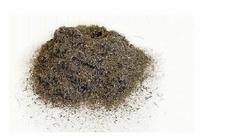When the prestigious Ehrlich II 'magic bullets' conference opens in Nurnberg, Germany, in October, one of Jamaica's scientists, Dr Henry Lowe, is expected to be present to make known his anti-cancer/anti-inflammatory research on a local plant, known as ball moss.
This conference is dedicated to Paul Ehrlich, who became famous as one of the main founders of chemotherapy. The conference is being held to commemorate the 100th anniversary of Ehrlich's Nobel Prize award. In his Nobel Lecture on December 11, 1908, Ehrlich had, in fact, outlined the foundation of chemotherapy and the use of drugs to cure patients. He coined the term, 'magic bullets' which continues to be used in science in reference to important and clinically efficacious drugs.
'Magic bullets' will be discussed at the conference and vie for a Magic Bullet Award. In the past, Lowe, who has been working for the last six years with University of Maryland's scientist, Dr Joseph Bryant, to extract and test ball moss's (Tillandsia recurvata's) bioactive ingredient, was reluctant disclose the plant's name.
Cancer and HIV cure

Dried ball moss, a weed commonly seen in Jamaican gardens and on electric power lines, now being researched by Drs Henry Lowe and Joseph Bryant for its anti-cancer properties.
- photos by Rudolph Brown/Chief Photographer
However, 18 months have passed since the December 2007 filing and registration of his invention with the United States patent office and, as is standard, the information on his research has been released and is now public knowledge.
"I am now ready to make another filing of the additional progress (in the research with ball moss). Since the (first) filing, we have now done more work on the chemistry and we have also found that it is effective against HIV (the virus that causes AIDS)," he said.
Although compounds in the plant's material are showing strong action against HIV, the focus of Lowe's and his associate's work is on the anti-cancer effects of the plant found all over Jamaica. He said that the laboratory studies are indicating that the plant compounds effective in all the cancer cell lines; broad-base effect they have against cancer and the research is focusing on cancers of the breast and prostate; B16 melanoma and two cancers caused by HIV/AIDS B-cell lymphoma or non-Hodgskin's lymphoma and Kaposi's sarcoma.
"(The) cancer work is where we have made the greatest progress. We found that it was effective against the two AIDS-related cancers, so we worked backwards to see the HIV link," said Lowe.
Clump of bush
By now readers must be wondering, 'What is this ball moss plant?' You would have seen it all around the country on trees or on the live JPSCo wires. It is a greyish-green clump of bush, appearing almost like a pin cushion. Being an epiphyte (not a parasite), it lives on trees but does not feed on them. Most people, however, consider the plant a nuisance in their garden but Lowe never did.
"When I was a child, from tramcar days, my father used to take us for rides from downtown to Constant Spring, when we were well-behaved. I was just fascinated to know how they (ball moss) survived but couldn't get closer to them," Lowe said as he outlined his boyhood curiosity, which soon turned into a lifelong obsession.
After completing his master's degree in Australia, he returned home, all the time holding on to his obsession. He said that while working on ganja (marijuana) studies with the West and Lockhart team, he extracted a compound from some ball moss. He found that it was bioactive.
"But (research) is expensive and I didn't have the resources to continue. But I stored the material in a flask and carried it around with me to my various jobs I had it for 12 years in the civil service where I worked," Lowe said.
Clinical trials
He even kept some of the material in his refrigerator, all the time thinking, "I have a major bioactive material and maybe the cure for cancer". As luck, or maybe serendipity, would have it, after Lowe's retirement from Blue Cross Jamaica, he was introduced to Dr Joseph Bryant, a senior researcher at the University of Maryland's Department of Medicine. He works with transgenic animals (which carry human cancer) and on xenograft or heterograft (transplanted tumours from humans to animals), ideal for Lowe's intended ball-moss studies.
Bryant was excited to work with Lowe after seeing for himself the effect of ball-moss compounds and the rest is history, as they say. Six years into the research that looks like a possible 'cancer and HIV/AIDS cure' and Lowe and team are looking ahead to aggressively continue the studies and move into the clinical trials.
"It's (research is) very expensive and we have had offers of support from overseas interest to take it to stage one clinical trials. We have a number of overseas interests and then after that, we will ask the big pharmaceutical companies to take it," Lowe said.
eulalee.thompson@gleanerjm.com


Processed ball moss to which chemicals are added to extract active anit-cancer and anti-HIV ingredients.

